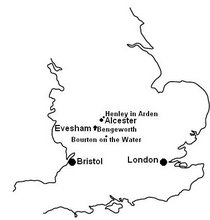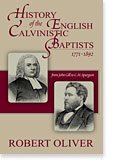This is from the entry in the English county history series, A History of the County of Gloucester: Volume 6 'Parishes: Bourton-on-the-Water' (1965), pp. 33-49. URL: http://www.british-history.ac.uk/report.aspx?compid=66425
Protestant Nonconformity.
Bourton has long had a strong tradition of religious nonconformity, which can be traced as far as the late 16th century when the puritan divine, Richard Stock, was domestic chaplain to the lessee of the manor. Anthony Palmer, ejected from Bourton rectory in 1661, removed to London, but another Congregationalist, John Dunce, who may have been Rector of Condicote during the Interregnum, was preaching at Bourton in 1667 and was given a licence for a meeting there in 1672. Figures for 1676 suggest that Bourton had a higher proportion and a far higher number of Protestant dissenters than anywhere else in Stow deanery.
The main strength of dissent in Bourton has been with the Baptists. The Baptist community there, said to have been founded in 1650, was represented by three men at the Baptist meeting of 1655 at Warwick. In 1660 two Bourton men were preaching as Baptists in Bury field (perhaps exploiting the ramparts of Salmonsbury); one of them was Thomas Collett, possibly the man who owned Nethercote manor, was a dissenting preacher in 1715, and was buried beside the Baptist chapel in 1720, and whose house was licensed for meetings in 1689. A barn licensed later the same year may have either replaced it or provided for another group of Baptists. Collett's group were Paedobaptists: in 1700 they opened a graveyard in Salmonsbury and in 1701 their newly built chapel was licensed. The group, however, seems not to have survived separately for very long, and to have been absorbed by another group of Baptists led by Joshua Head who was preaching in Bourton in 1690 and died in 1719. The absorption may have taken place after Head's death, when 48 Baptists signed certain articles of agreement, or perhaps in 1735: the licensing of two houses as meetings in that year may be the result of re-alignments among the Baptists, and in the same year a diocesan survey recorded that a congregation largely composed of Anabaptists heard sermons on alternate Sundays from an Anabaptist called Flower and a Presbyterian grazier called Collett, perhaps another owner of Nethercote: the distinction between Anabaptist and Presbyterian may be a mistake for that between Baptist and Paedobaptist. That the Baptist community in Bourton was in some confusion is attested in 1724 by the simultaneous licensing for dissenting worship of the houses of John Collett, Andrew Paxford, and Thomas Kyte, all in Bourton; the denomination is stated for none of them, but the first two have names with strong Baptist associations.
By 1740, when Benjamin Beddome, the hymnologist, began his 45 years as Baptist minister of Bourton, the Baptists appear to have been united, meeting in the chapel built in 1701. In 1748 a manse was built, and the chapel was rebuilt. A new chapel was opened in 1765 on the occasion of the meeting in Bourton of an association of 15 Baptist churches. The numbers of Baptists in the Bourton congregation rose from c100 in 1735 to nearly 200 in the 1750's; it included people from many neighbouring parishes, Naunton and Stow-on-the-Wold among them, and the severance of those places under their own ministers accounts for the apparent drop in numbers at Bourton before 1795. Beddome's death in that year was followed by dissension among the Baptists of Bourton, and it was not until 1801 that they were again united under a single permanent minister. By then the numbers had dropped to 47, and from this time the community was one of Particular Baptists. In the 1850's the membership was nearly 100, and was said to include a high proportion of the wealthier inhabitants. Congregations of over 400 were claimed.
The 18th century chapel, the site of which was visible in 1962 in the graveyard off Station Road, was replaced in 1876 by the church, built of stone with a Welsh slate roof, at the High Street end of Station Road. In 1962 the church, which was in membership with the Baptist Union, had branches at Aston Blank and Clapton, and membership totalled over a hundred.
The old manse was sold in 1928, and a new one built in Moore Road. The proceeds, £653, of the sale in 1950 of land belonging to the chapel was invested in stock, and another £300 was given for the maintenance of the church under the will of C V Wilkins (d 1951).
Rooms in private houses were registered for worship in 1829, 1831, and 1845 (the last two, apparently, for the same group). A Zion chapel in Lansdown, registered in 1843, may have been Methodist, but no return for it was made in 1851. By 1872 it was used as a school, and continued as such until 1902. The chapel was apparently the building converted into a private house by 1962 and bearing an inscription stone from which all but the date 1842 had been erased. A Primitive Methodist chapel in Clapton Row was built in 1868; in 1904 it became a Christadelphian meeting, and was still so used in 1962.





No comments:
Post a Comment